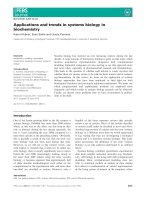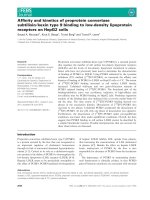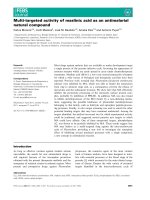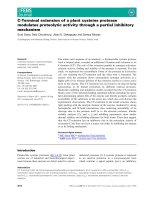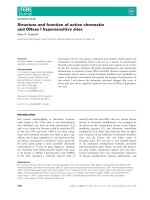Tài liệu Báo cáo khoa học: "MULTILINGUAL DATA" docx
Bạn đang xem bản rút gọn của tài liệu. Xem và tải ngay bản đầy đủ của tài liệu tại đây (342.02 KB, 4 trang )
SYN'I'ACI IC CONSTI~,,\INTS AND F~FI:ICIFNI' I~AI(SAI~,II.I'I'Y
Robert C. Berwick
Room 820, MIT Artificial Intelligence l,aboratory
545 Technology Square, Cambridge, MA 02139
Amy S. Weinberg
Deparuncnt of Linguistics, MIT
Cambridge, MA 02139
ABSTRACT
A
central goal of linguistic theory is to explain why natural
languages are the way they are. It has often been supposed that
com0utational considerations ought to play a role in this
characterization, but rigorous arguments along these lines have been
difficult to come by. In this paper we show how a key "axiom" of
certain theories of grammar, Subjacency, can be explained by
appealing to general restrictions on on-line parsing plus natural
constraints on the rule-writing vocabulary of grammars. The
explanation avoids the problems with Marcus' [1980] attempt to
account for the same constraint. The argument is robust with respect
to machine implementauon, and thus avoids the problems that often
arise wilen making detailed claims about parsing efficiency. It has the
added virtue of unifying in the functional domain of parsing certain
grammatically disparate phenomena, as well as making a strong claim
about the way in which the grammar is actually embedded into an
on-line sentence processor.
I INTRODUCTION
In its short history, computational linguistics has bccn driven by
two distinct but interrelated goals. On the one hand, it has aimed at
computational explanations of distinctively human linguistic behavior
that is, accounts of why natural languages are the way they are
viewed from the perspective of computation. On the other hand, it has
accumulated a stock of engineenng methods for building machines to
deal with natural (and artificial) languages. Sometimes a single body
of research has combined both goals. This was true of the work of
Marcus [1980]. for example. But all too often the goals have remained
opposed even to the extent that current transformational theory has
been disparaged as hopelessly "intractable" and no help at all in
constructing working parsers.
This paper shows that modern transformational grammar (the
"Government-Binding" or "GB" theory as described in Chomsky
[1981]) can contribute to both aims of computational linguistics. We
show that by combining simple assumptions about efficient parsability
along with some assumpti(ms about just how grammatical theory is to
be "embedded" in a model of language processing, one can actually
explain some key constraints of natural languages, such as Suhjacency.
(The a)gumcnt is differmlt frt)m that used in Marcus
119801.)
In fact,
almost the entire pattern of cunstraints taken as "axioms" by the GB
thct)ry can be accutmtcd tbr. Second, contrary to what has sometimes
been supposed, by exph)iting these constraints wc can ~how that a
Gll-based theory is particularly compatil)le v~idl efficient parsing
designs, in particdlar, with extended I I~,(k,t) parsers (uf the sort
described by Marcus [1980 D. Wc can extcnd thc I,R(k.t) design to
accommodate such phenomena as antecedent-PRO and pronominal
binding. Jightward movement, gappiug, aml VP tlcletion.
A, Functional Explanations o__f I,ocality Principles
Let us consider how to explain locality constraints in natural
languages. First of all, what exactly do we mean by a "locality
constraint"? "]'he paradigm case is that of Subjacency: the distance
between a displaced constituent and its "underlying" canonical
argument position cannot be too large, where the distance is gauged (in
English) in terms of the numher of the number of S(entence) or NP
phrase boundaries. For example, in sentence (la) below, John (the
so-called "antecedent") is just one S-boundary away from its
presumably "underlying" argument position (denoted "x", the
"trace")) as the Subject of the embedded clause, and the sentence is
fine:
(la) John seems [S x to like ice cream].
However, all we have to do ts to make the link between John and x
extend over two S's, and the sentence is ill-formed:
(lb) John seems [S it is certain [S x to like ice cream
This restriction entails a "successive cyclic" analysis of
transformational rules (see Chomsky [1973]). In order to derive a
sentence like (lc) below without violating the Subjacency condition,
we must move the NP from its canonical argument position through
the empty Subject position in the next higher S and then to its surface
slot:
(lc) John seems tel to be certain x to get the ice cream.
Since the intermediate subject position is filled in (lb) there is no licit
derivation for this sentence.
More precisely, we can state the Subjacency constraint as follows:
No rule of grammar can involve X and Y in a configuration like the
following,
[ x [,, [/r Y ] l X ]
where a and # are bounding nodes (in l.'nglish, S or NP phrases). "
Why should natural languages hc dcsigned Lhis way and not some
other way? Why, that is, should a constraint like Subjaccncy exist at
all? Our general result is that under a certain set of assumptions about
grammars and their relationship to human sentence processing one can
actually expect the following pattern of syntactic igcality constraints:
(l) The antecedent-trace relationship must
obey Subjaccncy, but other "binding"
realtionships (e.g., NP Pro) need not obey
Subjaccncy.
119
(2) Gapping constructitms must be subject
to a bounding condition resembling
Subjacency. but VP deletion nced not be.
(3) Rightward movemcnt must be stricdy
bounded.
To the extent that this predicted pattern
of
constraints is actually
observed as it is in English and other languages we obtain a
genuine functional explanation of these constraints and support for the
assumptions themselves. The argument is different from Man:us'
because it accounts for syntactic locality constraints (like Subjaceney)
,as the joint effect of a particular theory of grammar, a theory of how
that grammar is used in parsing, a criterion for efficient parsability.
and a theory of of how the parser is builL In contrast, Marcus
attempted to argue that Subjaceney could be derived from just the
(independently justified) operating principles of a particular kind of
parser.
B. Assumptions.
The assumptions we make are the following:
(1) The grammar includes a level of
annotated surface structure indicating how
constituents have been displaced from their
canonical predicate argument positions.
Further, sentence analysis is divided into
two stages, along the lines indicated by tile
theory of Government and Binding: the
first stage is a purely syntactic analysis that
rebuilds annotated surface structure; the
second stage carries out the interpretation
of variables, binds them to operators, all
making use of the "referential indices" of
NPs.
(2) To be "visible" at a stage of analysis a
linguistic representation must be written in
the vocabulary of that level. For example,
to be affected by syntactic operations, a
representation must be expressed in a
syntactic vocabulary (in the usual sense); to
be interpreted by operations at the second
stage, the NPs in a representation must
possess referential indices. (This
assumption is not needed to derive the
Subjaccncy constraint, but may be used to
account for another "axiom" of current
grammatical theory, the so-called
"constituent command" constraint on
antecedcnLs and the variables that they
hind.) This "visibility" assumption is a
rather natural one.
(3) The rule-writing vocabulary of the
grammar cannot make use of arithmetic
predicates such as "one", "two" or "three".
but only such predicates as "adjacent".
Further, quzmtificational statements are not
allowed m rt.les. These two assumptions
are also rather standard. It has often been
noted that grammars "do not count" that
grammatical predicates are structurally
based. There is no rule of grammar that
takes the just the fourth constituent of a
sentence and moves it, for example. In
contrast, many different kinds of rules of
grammar make reference to adjacent
constituents. (This is a feature found in
morphological, phonological, and syntactic
rules.)
(4) Parsing is no ! done via a method that
carries along (a representation) of all
possible derivations in parallel. In
particular, an Earley-type algorithm is ruled
out. To the extent that multiple options
about derivations are not pursued, the parse
is "deterministic."
(5) The left-context of the parse (as defined
in Aho and Ullman [19721) is literally
represented, rather than generatively
represented (as, e.g., a regular set). In
particular, just the symbols used by the
grammar (S, NP. VP ) are part of the
left-context vocabulary, and not "complex"
symbols serving as proxies for the set of
lefl context strings. 1 In effect, we make the
(quite strong) assumption that the sentence
processor adopts a direct, transparent
embedding of the grammar.
Other theories or parsing methods do not meet these constraints
and fail to explain the existence of locality constraints with respect to
thts particular set of assumpuons. 2 For example, as we show, there is
no reason to expect a constraint like Subjacency in the Generalized
Phrase Structure Grammars/GPSGsl of G,zdar 119811, because there
is no inherent barrier to eastly processing a sentence where an
antecedent and a trace are !.mboundedly far t'rt~m each other.
Similarly if a parsing method like Earlcy's algorithm were actually
used by people, than Sub]acency remains a my:;tcry on the functional
grounds of efficient parsability. (It could still be explained on other
functional grounds, e.g., that oflearnability.)
II PARSING AND LOCALITY PRINCIPLES
To
begin
the
actual argument then, assume that on-line sentence
processing is done by something like a deterministic parser)
Sentences like (2) cause trouble for such a parser:
(2) What i do you think that John told Mary mat ne
would like to eat %
t. Recall that the suoec.~i~'e lines of a left- or right-most derivation in a context-free
grammar cnnstttute a regular Language. ~.~ shown m. e.g DcRemer [19691.
2. Plainly. one is free to imagine some other set of assumptions that would do the job.
3. If one a.ssumcs a backtracking parser, then the argument can also be made to go
through, but only by a.,,,,~ummg that backtracking Ks vcr/co~tlS, Since this son of parser
clearly ,,~ab:~umes the IR(kPt,',pe machines under t/le right co,mrual of 'cost". we make
the stronger assumption of I R(k)-ncss.
120
The
problem is
that on recognizing the verb eat the parser must decide
whether to expand the parse with a trace (the transitive reading) or
with no postverbal element (.the intransitive reading). The ambiguity
cannot be locally resolved since eat takes both readings. It can only be
resolved by checking to see whether there is an actual antecedent.
Further, observe that this is indeed a parsing decision: the machine
must make some decision about how to tu build a portion of the parse
tree. Finally, given non-parallelism, the parser is not allowed to pursue
both paths at
once:
it must decide now how to build the parse tree (by
inserting an empty NP trace or not).
Therefore, assuming that the correct decision
is
to be made
on-line
(or
that retractions of incorrect decisions
are
costly) there must be an
actual parsing rule that expands a category as transitive iff there is an
immediate postverbal NP in the string (no movement) or if an actual
antecedent is present. However, the phonologically overt antecedent
can be unboundedly far away from the gap. Therefore, it would seem
that the relevant parsing rule would have to refer to a potentially
unbounded left context. Such a rule cannot be stated in the finite
control table of an I,R(k) parser. Theretbre we must find some finite
way of expressing the domain over which the antecedent must be
searched.
There are two ways of accomplishing this. First, one could express
all possible left-contexts as somc regular set and then carry this
representation along in the finite control table of the I,R(k) machine.
This is always pu,,;sible
m
the case of a contcxt-fiee grammar, and m
fact is die "standard" approach. 4 However, m the case of (e.g.) ,,h
moven!enk this demands a
generative encoding
of the
associated finite
state automaton,
via
the use of complex symbols like "S/wh"
(denoting the "state" that a
tvtt has
been encountered) and rules to pass
king this nun-literal representation of the state of the parse. Illis
approach works, since wc can pass akmg this state encoding through
the VP (via the complex non-terminal symbol VP/wh) and finally into
the embedded S. This complex non-terminal is then used to trigger an
expansion
of eat
into its
transitive form.
Ill
fact,
this
is precisely the
solution method advocated by Gazdar. We ~ce then that if one adopts
a non-terminal encoding scheme there should he no p,oblem in
parsing any single long-distance gap-filler relationship. That is, there
is no need for a constraint like Subjacency. s
Second, the problem of unbounded left-context is directly avoided
if the search space is limited to some literally finite left context. But
this is just what the Sttbjacency c(mstraint does: it limits where
an
antecedent NP could be to an immediately adjacent
S
or
S.
This
constraint has a StlllpJe
intcrprctatum m an actual parser (like that built
hy Murcus [19};0 D. l'he IF-THEN pattern-action rules that make up
the Marcus parser's ~anite control "transi:ion table" must be finite in
order to he stored ioside a machine. The rule actions themselves are
literally finite. If the role patterns must be /herally stored (e.g., the
pattern [S [S"[S must be stored as an actual arbitrarily long string ors
nodes, rather than as the regular set S+), then these patterns must be
literally finite. That is, parsing patterns must refer to literally hounded
right
and left context (in terms of phrasal nodes). 6 Note Further that
4 Following the approactl of DcRemer []969], one budds a finHe stale automaton Lhat
reco~nl/es exactly Ihe set of
i¢[t-(OIIlext
strings that cain arise during the course of a
right-most derivation, the so-Gilled
ch,melert.sllcf'.nife s/ale ClUlOmC~lott.
5 l'laml}
the same
Imlds for
a
"hold cell" apploaeh [o compulm 8 filler-gap
relallonshipi
6. Actually Uteri. lhJ8 k;nd or device lall!; lllto lJae (~itegoly of bounded contc;~t parsing.
a.'~ defiued b~. I ]oyd f19(.)4].
this constraint depends on the sheer represcntability of the parser's
rule system in a finite machine, rather than on any details of
implementation. Therefore it will hold invariantly with respect to
rnactfine design no matter kind of machine we build, if" we assume a
literal representation of left-contexts, then some kind t)f finiteness
constraint is required. The robustness of this result contrasts with the
usual problems in applying "efficiency" results to explain grm'~T""'!cal
constraints. These often fail because it is difficult to consider all
possible implcmentauons simultaneously. However, if the argument is
invariant with respect to machine desing, this problem is avoided.
Given literal left-contexts and no (or costly) backtracking, the
argument so far motivates some bounding condition for ambiguous
sentences like these. However, to get the lull range of cases these
functional facts must interact with properties of the rule writing system
as defined by the grammar. We will derive the litct that the Imunding
condition must be ~acency (as opposed to tri- or quad-jaccncy) by
appeal to the lhct
that
grammatical c~m~tramts and rules arc ~tated in a
vocabtdary which is
non-c'vunmtg.
,',rithmetic predicates are
forbidden. But this means that since only the prediu~lte "ad].cent" is
permitted, any literal I)ouuding rc,~trict]oi] must be c.xprc,~)cd m tcrlllS
of adjacent domains: t~e~;ce Subjaccncy.
INert
that ",djacent" is also
an arithmetic predicate.) l:urthcr. Subjaccncy mu,,t appiy ~.o ,ill traces
(not ju',t traces of,mlb=guously traw~itive/imransi[ive vcrb,o in:cause a
restriction to just the ambiguous cases would low)ire using cxistentml
quantilicati.n. Ouantificatiomd predicates are barred in the rule
writing vocabulary of natural grammars. 7
Next we extend the approach to NP movement and Gapping.
Gapping
is
particularly interesting because it is difficult
~o
explain
why
this construction
(tmlike
other
deletiou
rules) is
bounded. That is,
why is (3) but not (4) grammatical:
(3) John will hit Frank and Bill will [ely P George.
*(4)John will hit Frank and I don't believe Bill will
[elvpGeorge.
The problem with gapping constructions is that the attachment
of
phonologically identical complements is governed by the verb that the
complement follows. Extraction tests show that in {5) the pilrase
u/?er
M'ao' attaches to V" whde in (6) it attaches to V" (See Hornstem and
Wemberg []981] for details.}
(5) John will
mn
aftcr Mary.
(6) John will arrivc after Mary.
In gapping structures, however, the verb of the gapped constituent ,s
not present in the string. Therefore. correct ,lltachrnent o( the
complement can only be guaranteed by accessing the antecedent in the
previous clause. If this is true however, then the boundlng argument
for Suhjacency applies to this ease as well: given deterministic parsing
of gapping done correctly, and a literal representation of left-context,
then gapping must be comext-bounded. Note that this is a particularly
7 Of course, there zs a anolhcr natural predic.atc Ihat would produce a finite bound on
rule context: i[ ~]) alld Irate hod I. bc in tile .ame S donlalll Prc~umahb', lhls is also an
Optlllt3 ~l;iI could gel reah,ed in qOII|C n.'Ittlral l~rJoln'iai~: ll'ic resuhing languages would
no( have ov,,:rt nlo~.eIIICill OUlside o[ an S. %o(e lllal Lhc naltllal plcdJc;des simply give
the ranta¢ of po~edble ndiulal granmlars. ]lot those actually rour~d.
The elimination
of
quanllfil',.llion predic~les is supportable on grounds o(acquisltton.
121
interesting example bccause it shows how grammatically dissimilar
operations like wh-movement and gapping can "fall together" in the
functional domain of parsing.
NP-trace and gaplSing constructions contrast with
antecedentY(pro)nominal binding, lexical anaphor relationships, and
VP deletion. These last three do not obey Subjacency. For example, a
Noun Phrase can be unboundedly far from a (phonologically empty)
PRO. even in tenns of
John i thought it was certain that [PRO i feeding himself]
would be easy.
Note though that in these cases the expansion of the syntactic tree does
no._At depend on the presence or absence of an antecedent
(Pro)nominals and Icxical anaphors are phonologically realized in the
string and can unambiguously tell the parser hew to expand the tree.
(After the tree is fully expanded the parser may search back to see
whether the element is bound to an antecedent, but this is not a
parsing decision,) VP deletion sites are also always locally detectable
from ~e simple fact that every sentence requires a VP. The same
argument applies to PRO. PRO is locally detectable as the only
phonologically unrealized element that can appear in an ungoverned
context, and the predicate "ungoverned" is local. 8 In short, there is no
parsing
decision that hinges on establishing the PRO-antecedent. VP
deletion-antecedent, t)r lexical anaphor-antecedent relationship. But
then, we should not expect bounding principles to apply in thcse cases,
and, in fact, we do not find these elements subject to bounding. Once
again then. apparently diverse grammaucal phcnomc,m behave alike
within a functional realm.
To summarize, we can explain why Subjacency applies to exactly
those elements that the grammar stipulates it must apply to. We do
this using both facts about the functional design of a parsing system
and properties of the formal rule writing vocabulary, l'o the extent
that the array of assumpuons about the grammar and parser actually
explain this observed constraint on human linguistic behavior, we
obtain a powerful argument that certain kinds of grammatical
represenumons and parsing dcstgns are actually implicated in human
sentence processing.
Chomsky, Noam [19811
Lectures on Gove,nmem and Binding,
Foris
Publications.
I)eRerner, Frederick [1969]
Practical 7"nms,':m~sJbr IR(k) I.angu,ges,
Phi) di.~scrtation, MIT Department of Electrical Engineering and
Computer Science.
Floyd, Robert [1964] "Bounded-context syntactic analysis."
Communtcations of the Assoctatiotl for Computing ,l.lachinery,
7, pp,
62-66.
Gazdar, Gerald [19811 "Unbounded dependencies and coordinate
structure,"
Linguistic Inquiry,
12:2 I55-184.
Hornstein. Norbert and Wcinherg, Amy [19811 "Preposition stranding
and case theory,"
LingutMic [nquio,,
12:1.
Marcus, Mitchell
[19801
A
Theory of Syntactic Recognition for Natural
Language,
M IT Press
111 ACKNOWLEDGEIvlENTS
This report describes work done at the Artificial Intelligence
Laboratory of the Massachusetts Institute ofl'cchnt)logy. Support for
the Laboratory's artificial intelligence research is prey)deal in part by
tiac Advanced P, esearch ProjccLs Agency of the Department of Defense
under Office ()f Naval Research Contract N00014-80-C-0505.
IV
REFERENCES
Aho, Alfred and Ullman, Jeffrey [1972]
The Theory of Parsing
Trnn.~lalion, attdCumpiiing,
vo[. [., Prentice-(-{all.
Chumsky, Noam [1973] "Conditions on 'rransformations,"in S.
Anders(m & P Kiparsky, eds. A
Feslschr(l'l [or Morris Halle.
Holt,
Rinehart and Winston.
8 F;hlce ~ ~s ungovcNicd fff a ~ovct'llcd t:~ F;L[:~c, and
a go~c,'m~J
is a bounded predicate,
i
hcmg Lcstrictcd Io mu~',dy a ~in~i¢ lllaX1111;il Drojcctlon (at worst
al|
S).
122


